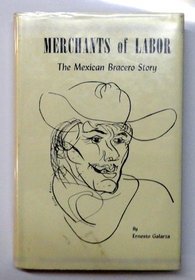The author was a 'troublemaker' whose research found that the large farm operations were exploiting labor through the Bracero Program in the 1950s. This book is confined to the time, although Galarzo did work in labor organizing (this being pre-UFW) when their efforts were crushed by agribusiness. Chapter 18, The Defeat of the Domestics, remains especially significant today by providing chapter and verse on how many American workers have lost out in finding fair employment. The endnotes reveal that he takes great care to offer 'just the facts' by basing his statements on government documents and testimony. While I believe this book still has value, I am not posting it because it circulated a couple of dozen times while on the shelf at the high school and thus its condition would not measure up to the high standards of many of my fellow PBS members.
Mr. Galarzo finds that allies of large operators falsely claimed that the Bracero Program was mostly used by small American farms. While some of the domestic workforce were alcoholics and the like, most were just as good (and at first better) than Mexican hands, contrary to what was argued in the passage of Public Law 78. The latter were paid two bits an hour for the first 48 hours (training period) but soon came up to snuff. What endeared them to large farmers was there willingness to undertake any job, and not to leave for another ranch or farm when poorly treated or badly paid, there being 2,000,000 unemployed Mexicans. Likewise the claim that Americans would not do certain kinds of stoop labor was false, per Mr. Galarza's research--domestic workers wanted fair pay and treatment.
The departure of Japanese field hands and families from the Coast in 1942 added to a shortage of farm labor and thus the Bracero Program. California farmers were also being threatened by loss of their labor force by higher wages and better working conditions in Oregon and Washington as well as opportunities in manufacturing, transportation, and service industries.
During the war, there were ceilings on the pay for crops so as to not pay too much for material needed in the war effort. After the war, there was a lack of housing for domestic working families who followed the crops and thus more Braceros were hired in the 1950s. A strike in 1951 saw the Mexican consul oppose American labor in favor of his countrymen.
The monies argued about endlessly at the end of the 20th C. that had been deducted from Bracero pay and that had disappeared from Mexican banks seems to have come from an insurance scheme included by law, being life insurance while on the job, worker's comp insurance being a separate matter.
Endnotes, index.
Mr. Galarzo finds that allies of large operators falsely claimed that the Bracero Program was mostly used by small American farms. While some of the domestic workforce were alcoholics and the like, most were just as good (and at first better) than Mexican hands, contrary to what was argued in the passage of Public Law 78. The latter were paid two bits an hour for the first 48 hours (training period) but soon came up to snuff. What endeared them to large farmers was there willingness to undertake any job, and not to leave for another ranch or farm when poorly treated or badly paid, there being 2,000,000 unemployed Mexicans. Likewise the claim that Americans would not do certain kinds of stoop labor was false, per Mr. Galarza's research--domestic workers wanted fair pay and treatment.
The departure of Japanese field hands and families from the Coast in 1942 added to a shortage of farm labor and thus the Bracero Program. California farmers were also being threatened by loss of their labor force by higher wages and better working conditions in Oregon and Washington as well as opportunities in manufacturing, transportation, and service industries.
During the war, there were ceilings on the pay for crops so as to not pay too much for material needed in the war effort. After the war, there was a lack of housing for domestic working families who followed the crops and thus more Braceros were hired in the 1950s. A strike in 1951 saw the Mexican consul oppose American labor in favor of his countrymen.
The monies argued about endlessly at the end of the 20th C. that had been deducted from Bracero pay and that had disappeared from Mexican banks seems to have come from an insurance scheme included by law, being life insurance while on the job, worker's comp insurance being a separate matter.
Endnotes, index.




